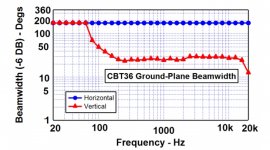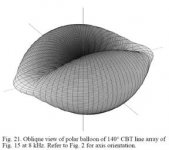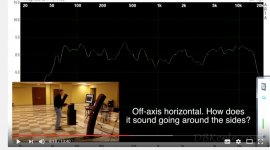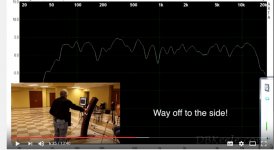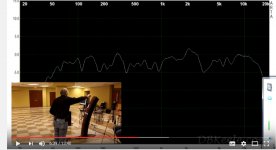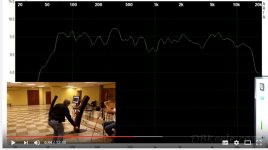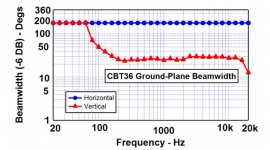Thanks for the video....Wouldn't the CBT24 theoretically not display the tightening and then blooming of horizontal directivity around 900hz and ~3khz? I noticed the JBL CBT columns have the tweeter line situated coaxially, which would help mitigate this.
Well this isn't going to make a few people very happy but I feel the need to comment. There are many factors involved but the testing and location are not to fault (I was there helping Don Keele). I few things I can speculate on but I'll avoid that.
This is a good example of the tradeoffs when trying to meet a price point. The tweeter here is the real problem. This type of driver is actually more common in smaller devices like laptops. In my opinion it doesn't translate well to this type of speaker design. The main benefit it has it the close spacing which allows greater control in the vertical directivity in the top two octaves. It also has a very low Fs for a driver this size but that comes with some significant penalties. There are other issues too, but again, the pricing of the kit is a major constraint.
Exactly....my issue here is Keele claims "Provides broadband constant-directivity, beamwidth and coverage" and puts it a number of different ways. I'm sure these are great speakers, and am going to buy some to test, but this claim seems to be sensational at best. I say this with all due respect. 360 degrees dispersion at ~500-700hz is no different from a conventional speaker system.
I was initially perplexed how a shaded vertical or arced(delayed) line of woofers could provide significant pattern control at low frequencies in the horizontal, but beyond people claiming that I can't see it demonstrated.
Brett
I understand your point of view but I think there are some advantages to the horizontal pattern than haven't yet been explored. I don't think Don is trying to mislead anyone - especially since he was one of the early "founders" on constant directivity horns. If you were to measure a point source system and CBT in the horizontal plane at different angles and microphone heights it would be interesting to compare the two.
I understand your point of view but I think there are some advantages to the horizontal pattern than haven't yet been explored. I don't think Don is trying to mislead anyone - especially since he was one of the early "founders" on constant directivity horns. If you were to measure a point source system and CBT in the horizontal plane at different angles and microphone heights it would be interesting to compare the two.
All points taken and agreed Rick; we're all just trying to make it sound better at the end of the day no?
Brett
Rick I'd love to see one....and also try to determine whether is matters. This system is obviously focused on the vertical moreso that the horizontal, and that is ok I think. That being said, I'm a theatrical prosound guy, so horizontal CD is important to me.
At the end of the day we're seeing these beautiful sonograms from the point-source waveguide people....they look really, really good. I've built some and they sound really good; amazingly good honestly, and they are simple and cheap to build. I'd sure like to know if this CBT is a step up, and we need to have a way to quantify as well as quantify it.
Best,
Brett
Your real problem is all of those open mics in a scene...lol
Seriously, I respect what you do having mixed for live sound music and theatrical events.
JBL's CBT's are quite different compared to what Don and I have been doing. I helped build some large CBT arrays for my church and that's what spurred my interest in building arrays for home audio and HT. For your situation I think it depends on the venue and what your constraints are for placement and aesthetics. Personally I don't care much for the sound of many compression drivers and the ones I did find acceptable were very expensive.
Your real problem is all of those open mics in a scene...lol
Seriously, I respect what you do having mixed for live sound music and theatrical events.
JBL's CBT's are quite different compared to what Don and I have been doing. I helped build some large CBT arrays for my church and that's what spurred my interest in building arrays for home audio and HT. For your situation I think it depends on the venue and what your constraints are for placement and aesthetics. Personally I don't care much for the sound of many compression drivers and the ones I did find acceptable were very expensive.
Haha no kidding....on a more serious note aesthetics and price-point are indeed the two driving factors in what we do as well. Here is what we have been playing with lately: Dipole low/mid transitioning to cone beaming to waveguide control. They work great because they put the singer(wearing an omni mic) right in the dipole null. Makes life a lot easier.
https://www.youtube.com/watch?v=HlYiIho5c1A
Brett
I understand your point of view but I think there are some advantages to the horizontal pattern than haven't yet been explored. I don't think Don is trying to mislead anyone - especially since he was one of the early "founders" on constant directivity horns. If you were to measure a point source system and CBT in the horizontal plane at different angles and microphone heights it would be interesting to compare the two.
Here ya go
These are the 3D polars of a CBT. I took this measurement from one page ago. Note that directivity is controlled in the vertical plane, but not the horizontal
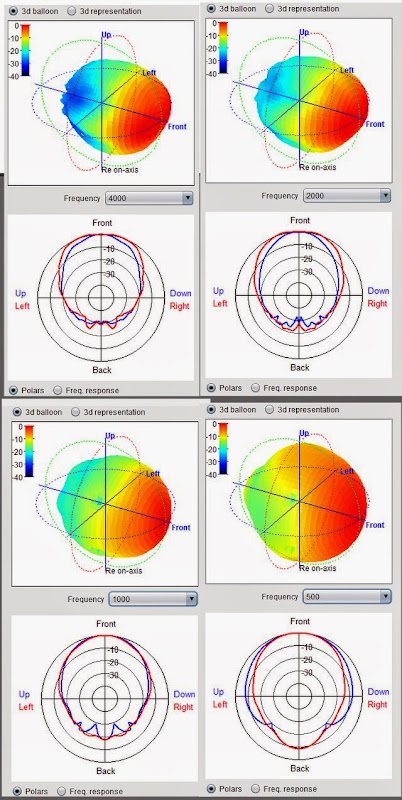
Here's a Danley SH96. Note the directivity is narrower and it's (mostly) symmetrical.
You can sim any of the Danley speakers using the tools posted on their website
I posted the data here (Suitable midrange cone, for bandpass mid in Unity horn.) four years ago
One subjective observation : I've listened to CBTs and I've listened to Danley Synergy Horns. One "complaint" that I had with the SH50, if you can call it a "complaint", was that crummy recordings sound crummy. IE, it's one of those speakers that really rewards a nicely done recording, but if your recording is junk, the SH50 won't hide that.
I wonder if the CBT, with it's wide horizontal directivity, is adding some "ambience" to the mix? I would definitely say that the CBT sounds more spacious.
A CBT won the recent MWAF, so there may be some good reasons for narrow vertical and wide horizontal directivty. JBL has gone this route with their cinema speakers.
I wonder if the CBT, with it's wide horizontal directivity, is adding some "ambience" to the mix? I would definitely say that the CBT sounds more spacious.
A CBT won the recent MWAF, so there may be some good reasons for narrow vertical and wide horizontal directivty. JBL has gone this route with their cinema speakers.
Due to the backwards bend nature of the CBT from Keele it will average out early reflections of walls and big objects. As each driver in the array is at a different location this will help lower first reflections compared to the direct sound. The sound is still reflected, but not at a level you'd see with a point source. As each driver will have its first reflection at a slightly different spot. Compensated for by all other drivers direct energy.
This will no doubt help it have a clearer sound. But technically it does not avoid the refections, they are averaged out.
This will no doubt help it have a clearer sound. But technically it does not avoid the refections, they are averaged out.
Due to the backwards bend nature of the CBT from Keele it will average out early reflections of walls and big objects. As each driver in the array is at a different location this will help lower first reflections compared to the direct sound. The sound is still reflected, but not at a level you'd see with a point source. As each driver will have its first reflection at a slightly different spot. Compensated for by all other drivers direct energy.
This will no doubt help it have a clearer sound. But technically it does not avoid the refections, they are averaged out.
Are you sure?
In the forward lobe, the CBT is an expanding array.
But in the backwards lobe, it's actually focused on the back wall. (To the back, it's a focused array.)

Like this, in reverse
It's a little hard to read the directivity from that balloon. And I'm not sure if the balloon is from CBT36 or a smaller CBT prototype. I'll check this.
But if you look at the beamwidth of CBT36 from the manual, you'll see it's 180-200 degrees. I believe it's closer to 180 degrees, 90 degrees to each side.
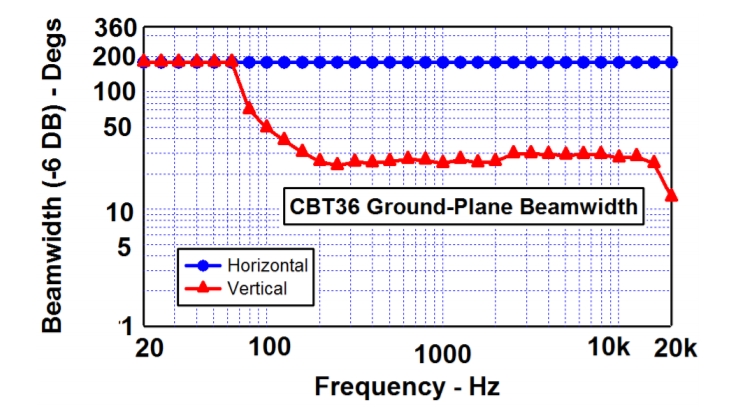
While this isn't actual measurement (a simulatation) it corresponds well with my measurements in an actual room. I haven't seen high gain specular reflections from the front wall, which would be the case if it was omni. With much toe in though in a very small/narrow room, I've seen reflections from the front wall corners but that can be explained with the wide 180 degrees beamwidth.
Another factor to mention is that the horizontal beamwidth decreases with height. At the bottom, it's narrower. This is what I believe we're seeing in the balloon I posted and it's also shown with this balloon:
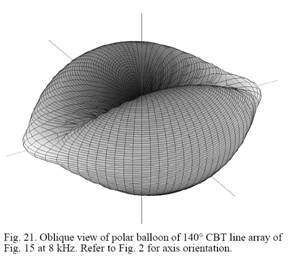
If we look at the actual off-axis measurement of CBT36 Don did in the room from the video, I would say the horizontal shows an incredible consistency. Remember that it's shown with 5 dB large increments. Even far to the side (perhaps 70 degrees?), the response is within 3 dB. Not only does it do that at one height, but at all heights! While the horizontal isn't perfect, it's darn good and I don't know any speakers that are close to this when we include different heights. An omni speaker like MBL is only constant at one height.
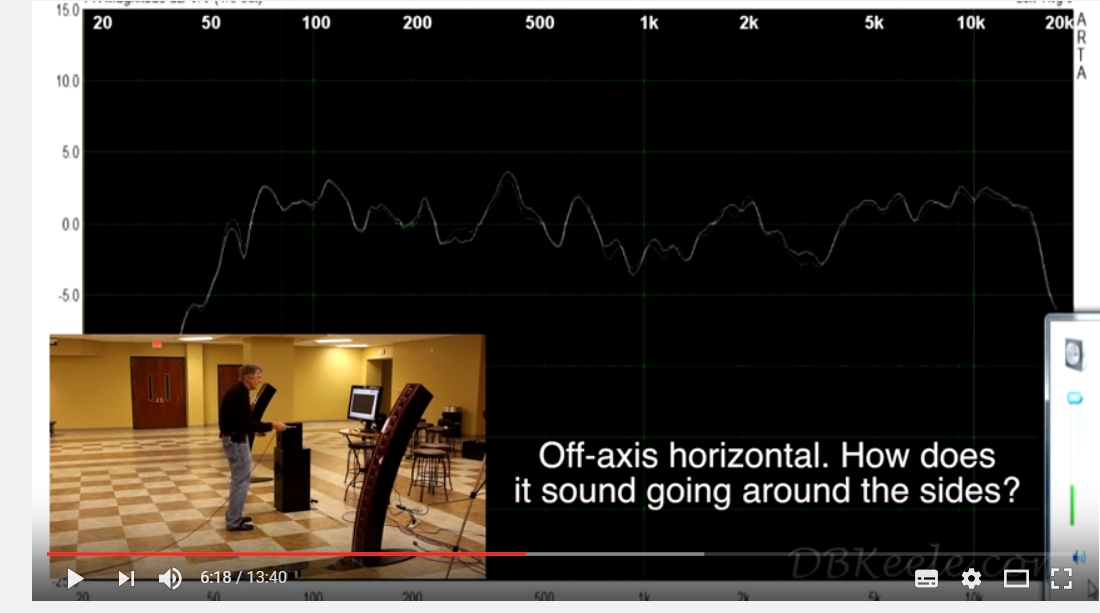
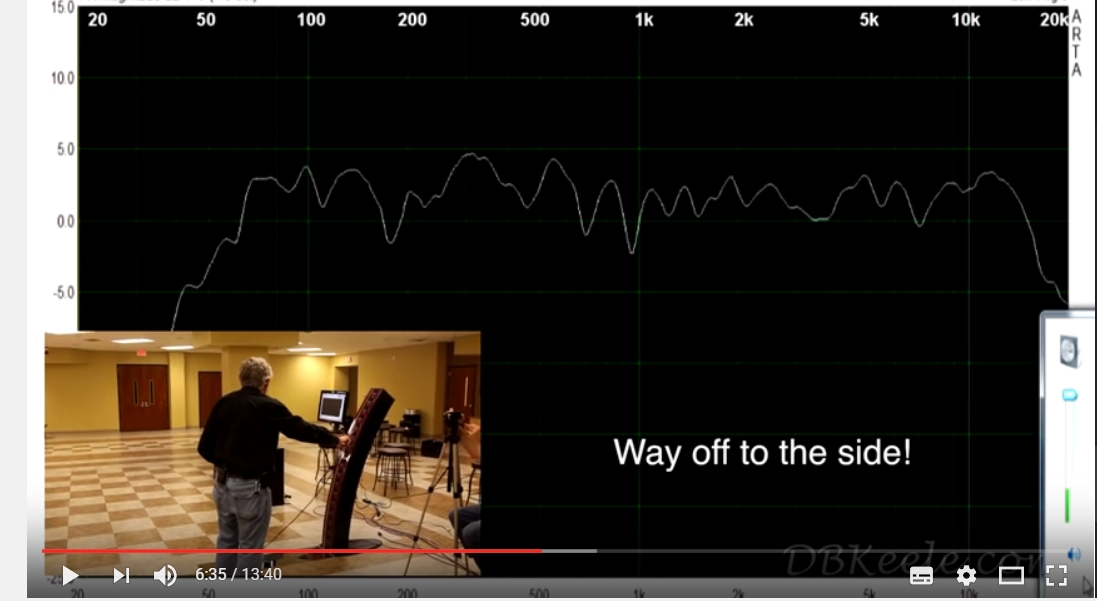
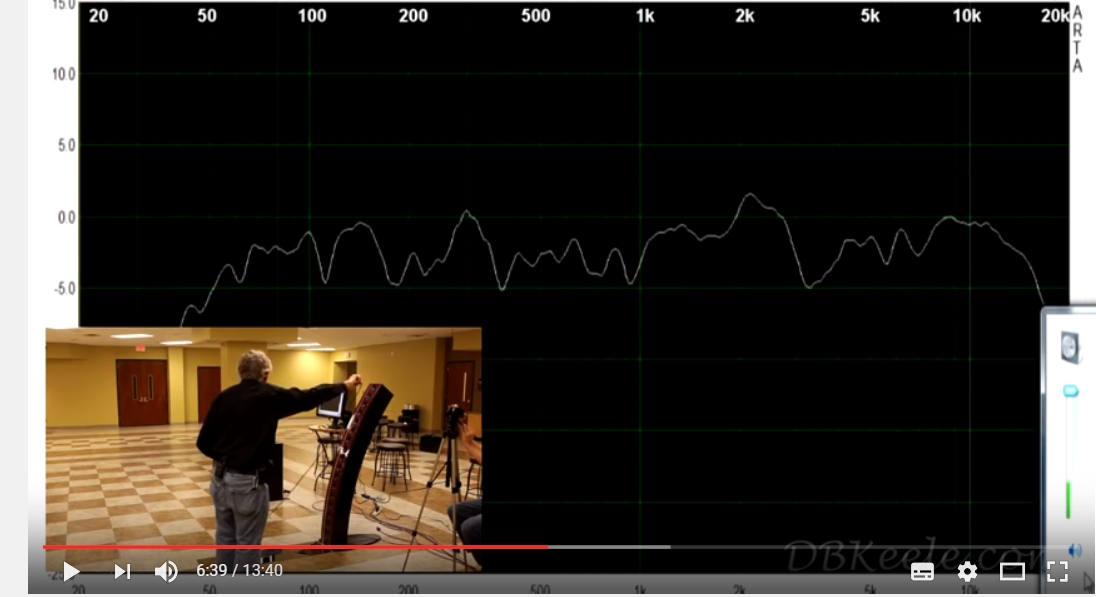
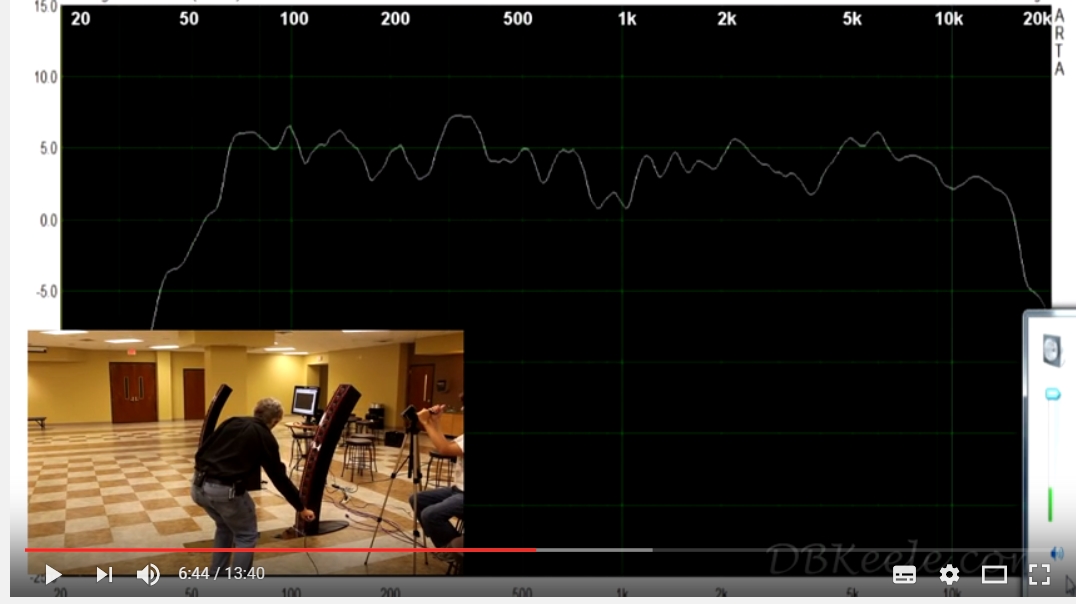
Just to avoid any misunderstanding; a controlled directivity doesn't necessarily imply a narrow dispersion. People use the words differently, but controlled basically implies a uniform directivity that doesn't change much. In this regard the CBTs are controlled which the video shows. However, a CBT like CBT24 and CBT26 have wide dispersion. CBT36 is wider higher in frequency than CBT24 due to the fact it's using smaller drivers in this area. When it comes to how a CBT reacts to the baffle (which Patrick pointed out), I'm really not sure if it's similar to a typical frontfiring speaker. I'll find out.
If you compare the CBT with a typical waveguide speaker where the waveguide only operates from 1-2KHz, there's no comparison. The waveguide speaker has a collapsing polar which is very audible when you compare it to a speaker with constant directivity much lower in frequency. The rapid change in beamwidth at a very audible range, colors the sound and it doesn't sound natural/right unless you treat the side walls with broadband treatment. I have heard this several times when comparing Abbey to CBT36 and my visiting friends who have listened to both preferred CBT36 by far. With direct comparison it's easily heard. The CBT36 sounds sounds correct in tonality with no side wall treatment (though you get flutter echo with no furnitures), while the Abbeys don't. I have also worked with PA by the way and have set up and listened to many other waveguide speakers.
You also see the lack of controlled direcitivty below the operation from the waveguide in the frequency response measurements. It becomes very uneven in a living room, while the CBT36 changes little above 300-400 Hz in most rooms.
However, if you compare a huge horn speaker with controlled directivty to 300-400 Hz with the CBT it's completely different comparison. I have done that too. And here they are more different than one being better. The horn avoids side wall reflections to a larger degree, while the CBT has a wide dispersion with lateral contribution. Obviously one can treat the side walls with absorption and they are much closer again. Anyone who wants the best imaging and accuracy should really use treatment with both types of speakers in a small room. But without any side wall treatment, the horn will yield better imaging while CBT will sound more spacious. It's really a matter of taste. A large horn speaker does have advantages of high sensitivity and better midbass capability than CBT36, which makes it more engaging to listen to but those things can be achieved with different drivers in a CBT as well. CBT36 has a very low sensitivity because of it's small and inefficient drivers.
Vertically the CBT is more uniform than the horn. And while the horn minimizes floor reflections, the CBT completely avoids them. Ceiling reflections are very similar and dependent on the CBT arc and the shape of the horn but the CBT holds it's direcitivity lower in frequency even compared to a very large horn.
IMO, the discussion shouldn't be about a rather small horn speaker vs CBT but a horn speaker with directivity down to 500 Hz or lower vs CBT. They are both great and I personally love both.
Obviously I'm takling about the regular circular-arc line arrays here. It possible to make a CBT in other ways and minimize the horizontal directivity. That can be done several ways and it would also make the CBT even more uniform. However, in polar plot with 1/3 smoothing this would not necessarily be seen. You would most likely need graphs with higher resolution.
But if you look at the beamwidth of CBT36 from the manual, you'll see it's 180-200 degrees. I believe it's closer to 180 degrees, 90 degrees to each side.
While this isn't actual measurement (a simulatation) it corresponds well with my measurements in an actual room. I haven't seen high gain specular reflections from the front wall, which would be the case if it was omni. With much toe in though in a very small/narrow room, I've seen reflections from the front wall corners but that can be explained with the wide 180 degrees beamwidth.
Another factor to mention is that the horizontal beamwidth decreases with height. At the bottom, it's narrower. This is what I believe we're seeing in the balloon I posted and it's also shown with this balloon:
If we look at the actual off-axis measurement of CBT36 Don did in the room from the video, I would say the horizontal shows an incredible consistency. Remember that it's shown with 5 dB large increments. Even far to the side (perhaps 70 degrees?), the response is within 3 dB. Not only does it do that at one height, but at all heights! While the horizontal isn't perfect, it's darn good and I don't know any speakers that are close to this when we include different heights. An omni speaker like MBL is only constant at one height.
Just to avoid any misunderstanding; a controlled directivity doesn't necessarily imply a narrow dispersion. People use the words differently, but controlled basically implies a uniform directivity that doesn't change much. In this regard the CBTs are controlled which the video shows. However, a CBT like CBT24 and CBT26 have wide dispersion. CBT36 is wider higher in frequency than CBT24 due to the fact it's using smaller drivers in this area. When it comes to how a CBT reacts to the baffle (which Patrick pointed out), I'm really not sure if it's similar to a typical frontfiring speaker. I'll find out.
If you compare the CBT with a typical waveguide speaker where the waveguide only operates from 1-2KHz, there's no comparison. The waveguide speaker has a collapsing polar which is very audible when you compare it to a speaker with constant directivity much lower in frequency. The rapid change in beamwidth at a very audible range, colors the sound and it doesn't sound natural/right unless you treat the side walls with broadband treatment. I have heard this several times when comparing Abbey to CBT36 and my visiting friends who have listened to both preferred CBT36 by far. With direct comparison it's easily heard. The CBT36 sounds sounds correct in tonality with no side wall treatment (though you get flutter echo with no furnitures), while the Abbeys don't. I have also worked with PA by the way and have set up and listened to many other waveguide speakers.
You also see the lack of controlled direcitivty below the operation from the waveguide in the frequency response measurements. It becomes very uneven in a living room, while the CBT36 changes little above 300-400 Hz in most rooms.
However, if you compare a huge horn speaker with controlled directivty to 300-400 Hz with the CBT it's completely different comparison. I have done that too. And here they are more different than one being better. The horn avoids side wall reflections to a larger degree, while the CBT has a wide dispersion with lateral contribution. Obviously one can treat the side walls with absorption and they are much closer again. Anyone who wants the best imaging and accuracy should really use treatment with both types of speakers in a small room. But without any side wall treatment, the horn will yield better imaging while CBT will sound more spacious. It's really a matter of taste. A large horn speaker does have advantages of high sensitivity and better midbass capability than CBT36, which makes it more engaging to listen to but those things can be achieved with different drivers in a CBT as well. CBT36 has a very low sensitivity because of it's small and inefficient drivers.
Vertically the CBT is more uniform than the horn. And while the horn minimizes floor reflections, the CBT completely avoids them. Ceiling reflections are very similar and dependent on the CBT arc and the shape of the horn but the CBT holds it's direcitivity lower in frequency even compared to a very large horn.
IMO, the discussion shouldn't be about a rather small horn speaker vs CBT but a horn speaker with directivity down to 500 Hz or lower vs CBT. They are both great and I personally love both.
Obviously I'm takling about the regular circular-arc line arrays here. It possible to make a CBT in other ways and minimize the horizontal directivity. That can be done several ways and it would also make the CBT even more uniform. However, in polar plot with 1/3 smoothing this would not necessarily be seen. You would most likely need graphs with higher resolution.
Attachments
This is incorrect.Due to the backwards bend nature of the CBT from Keele it will average out early reflections of walls and big objects. As each driver in the array is at a different location this will help lower first reflections compared to the direct sound. The sound is still reflected, but not at a level you'd see with a point source. As each driver will have its first reflection at a slightly different spot. Compensated for by all other drivers direct energy.
This will no doubt help it have a clearer sound. But technically it does not avoid the refections, they are averaged out.
First of all, you will not see lower levels of reflections if the reflection came "at a slightly different spot" as you described. It would be the opposite; you would have more high gain reflections because they would be coming from more surfaces.
Secondly, the energy from the CBT is more or less time coherent. With a FIR filter it yields actually close to perfect square waves. This is actually the core and advantage with the CBT technology with it's shading network and bending and is why it performs so well and much better than a line array.
Yes. I'm pretty shure about that. Just as a straight floor to ceiling array does not 'avoid' floor and ceiling reflections.Are you sure?
In the forward lobe, the CBT is an expanding array.
But in the backwards lobe, it's actually focused on the back wall. (To the back, it's a focused array.)

Like this, in reverse
But for all practical purposes it acts that way.
Its like using an array of microphones to avoid room effects. It doesn't avoid the walls but due to each element having its reflection at slightly different positions they don't sum at the listening position as one big reflection.
It will still 'add' a room sound, but not as focussed.
They should need some spacing from walls as you could be right about the focus point at the center of the array's curve.
Can't agree with that, sorry. The CBT will have reduced reflections compared to a single source with the same directivity driver.This is incorrect.
First of all, you will not see lower levels of reflections if the reflection came "at a slightly different spot" as you described. It would be the opposite; you would have more high gain reflections because they would be coming from more surfaces.
Secondly, the energy from the CBT is more or less time coherent. With a FIR filter it yields actually close to perfect square waves. This is actually the core and advantage with the CBT technology with it's shading network and bending and is why it performs so well and much better than a line array.
Look up how arrayed microphones work for measurements and it will start to make more sense.
Last edited:
It does not avoid the floor, it uses those reflections to make up the other half of the array. Big difference. That makes it 'seem' to avoid the floor. Its a good concept which emulates a wave front as if it were comming from the center of the array's arc.Reflections from a CBT wil depend on it's directivity. CBT36 and CBT24 avoid floor reflections and greatly reduces ceiling reflections as mentioned many times.
But that does not detract anything from what I was saying. Which was all positive by the way
Last edited:
Seriously man, this is straw man argument and seems more important for you to win the discussion.It does not avoid the floor, it uses those reflections to make up the other half of the array. Big difference. That makes it 'seem' to avoid the floor. Its a good concept which emulates a wave front as if it were comming from the center of the array's arc.
But that does not detract anything from what I was saying. Which was all positive by the way.
Were we not talking about actual reflections from the room? And doesn't the CBT avoid that?
I don't mean this is bad way or personal but your reply in #48 shows a complete lack of basic understanding of both how the speaker and acoustics works. It's totally off and wrong in every way. It's actually quite humorous but at they time a bit frustrating when people cannot acknowledge the lack of understanding (and it's nothing wrong with being wrong!) but continue debating with an ignorance of the basics.
I recommend you tovactually look at what's really happening. I'm sure Keele understands what I am saying. His papers indicata that. You simply can't change physics. Think of it what you will. What do you think is happening? Magic?Seriously man, this is straw man argument and seems more important for you to win the discussion.
Were we not talking about actual reflections from the room? And doesn't the CBT avoid that?
I don't mean this is bad way or personal but your reply in #48 shows a complete lack of basic understanding of both how the speaker and acoustics works. It's totally off and wrong in every way. It's actually quite humorous but at they time a bit frustrating when people cannot acknowledge the lack of understanding (and it's nothing wrong with being wrong!) but continue debating with an ignorance of the basics.
Itt really seems you didn't understand a single word I wrote. Post more measurements and I'll prove it to you.
Feel free to feel sorry for me, or go think a little harder. For the last time: a CBT array does not avoid the floor reflection. It uses it in a positive manor. Which for all practicle purposes makes it seem like it's avoiding the floor. No way around it. I can't help you if you don't see that.
Not trying to sway you, its perfectly logical if you'd draw it out on a piece of paper.
If you insist it avoids the floor, how does that work exactly? The separate drivers stop acting like the drivers they are? It gets magically absorbed by the shading? Then why does Keely show an arc of twice the size of the CBT in his sims? One reason only, he included the effect of the floor reflection. Just like I was trying to point out.
This isn't a discussion. It is pointed out by Keele and I merely added the additional benefit the arc has for other reflections. Which you describe but can't or won't explain. All drivers in a CBT will act as the normal drivers they are. And the shape of the array (together with the shading) makes it behave the way it does. Draw the reflections out for yourself as rays towards the listening spot.
One driver will reflect on the floor at a single spot. When you take two drivers above each other they each will reflect at slightly different frequencies and have a less deep but wider dip. Repeat adding more drivers and it will seem like one larger array. Go figure out the why. This does not mean it avoids the reflection. It benefits from the reflection. Go ask Don.
It shouldn't be too hard to understand.
Ya, Wesayso, but post 48 was really strange. A spatially smoothly radiating source, in explanation radiating into only one lobe, may be called a point source but does not need to radiate omni-directionally. The latter is called a monopole, while Don's CBTs are rather hyper-cardioids belo spatial aliasing frequency, whose wavelength is center-to-center distance between bordering drivers. Above that frequency, post 48 is rite.
Last edited:
It's either become a straw man argument or there's some serious misunderstanding.
We were talking about actual specular reflections in the room from a CBT. And in the manner and in practice it's correct that CBT avoids the floor reflections. Or you might say it's not there or eliminates it. Doesn't really matter how you describe it and wasn't a discussion about exactly how this is accomplished. The point is there are basically no specular floor reflections from a ground plane CBT speaker. You can add absorption to the floor and reflections will not be attenuated anymore. The ground plane benefits from a reflective floor and avoids the bandlimited carpet issue other speakers have.
The 3D balloon that I posted earlier was of a very small CBT prototype from 2002, measured at JBLs arena. Sorry, I should have checked that out. So basically it's not the polar of CBT36 but of a much smaller 1-way CBT. I haven't seen other horizontal directivity than the simulation below of CBT36.
We were talking about actual specular reflections in the room from a CBT. And in the manner and in practice it's correct that CBT avoids the floor reflections. Or you might say it's not there or eliminates it. Doesn't really matter how you describe it and wasn't a discussion about exactly how this is accomplished. The point is there are basically no specular floor reflections from a ground plane CBT speaker. You can add absorption to the floor and reflections will not be attenuated anymore. The ground plane benefits from a reflective floor and avoids the bandlimited carpet issue other speakers have.
The 3D balloon that I posted earlier was of a very small CBT prototype from 2002, measured at JBLs arena. Sorry, I should have checked that out. So basically it's not the polar of CBT36 but of a much smaller 1-way CBT. I haven't seen other horizontal directivity than the simulation below of CBT36.
Attachments
However strange it may sound or rather read, it is a separate side effect from the array due to it's shape. The floor mirror works with the array to form its first wave front. (As if it were comming from a single point behind the array) The later arriving reflections from walls get spread out over time and will be reduced in level compared to a single source above the floor like a regular speaker. The focus point of the array is right on the floor. The one Patrick mentioned.Ya, Wesayso, but post 48 was really strange. A lobelessly radiating source may be called a point source but does not need to radiate omni-directionally. The latter is called a monopole, while Don's CBTs are rather hyper-cardioids belo spatial aliasing frequency, whose wavelength is center-to-center distance between bordering drivers. Above that frequency, post 48 is rite.
This helps it making it seem more directional at lower frequencies. While the induvidual drivers are as omni as they usually are when placed in such a small baffle. I won't comment on the cross over as that part is separate from this discussion of room reflections. For convenience we will assume ideal point source drivers as Keele used in the sims.
Maybe Patrick can find a way to simulate it? I have no tools here out in the sun in the middle of nowhere
- Status
- This old topic is closed. If you want to reopen this topic, contact a moderator using the "Report Post" button.
- Home
- Loudspeakers
- Multi-Way
- CBT24 line array speakers
